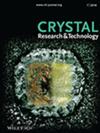Self‐Assembly Method for Insensitive DAAF/FOX‐7 Composite Crystals with Microspheres Structure
IF 1.9
4区 材料科学
Q3 CRYSTALLOGRAPHY
引用次数: 4
Abstract
Highly efficient design for the formulation of explosives is desired for accelerating the development of energetic materials. These investigations are focused on the preparation of the compounds 3,3′‐diamino‐4,4′‐azoxyfurazan (DAAF) and 1,1‐diamino‐2,2‐dinitroethylene (FOX‐7). DAAF/FOX‐7 microspheres are prepared via the self‐assembly method using different mass ratios of DAAF and FOX‐7. Materials Studio is used to analyze the intermolecular binding energy (Ebind) of the composite system. DAAF/FOX‐7 with a mass ratio of 90:10 shows a higher Ebind (183.24 kJ mol−1) and peak temperature at the heating rate of 0 °C min−1 (266.2 °C) than DAAF/FOX‐7 with a mass ratio of 70:30 and DAAF/FOX‐7 with a mass ratio of 80:20; this indicates that DAAF/FOX‐7 (90:10) shows better thermal stability. EXPLO5 is used to analyze the detonation velocity of the composite system, and the detonation velocity of DAAF/FOX‐7 microspheres increase by 0.5 km s−1 compared to that of DAAF. The characteristic drop height of impact sensitivity is more than 100 cm, and this demonstrates that the microspheres exhibit good safety performance. The morphology, crystal structure, thermal decomposition property, and impact sensitivity of the microspheres are investigated and compared. X‐ray diffraction and Fourier transform infrared spectroscopy results indicate that the structure of the DAAF/FOX‐7 composite is not changed compared to that of the raw material.微球结构不敏感DAAF/FOX - 7复合晶体的自组装方法
为了加速高能材料的发展,需要高效的炸药配方设计。这些研究主要集中在化合物3,3 ' -二氨基- 4,4 ' -氮氧呋喃氮(DAAF)和1,1 -二氨基- 2,2 -二亚基乙烯(FOX - 7)的制备上。采用DAAF和FOX‐7的不同质量比,通过自组装方法制备了DAAF/FOX‐7微球。使用Materials Studio分析复合体系的分子间结合能(Ebind)。质量比为90:10的DAAF/FOX‐7比质量比为70:30的DAAF/FOX‐7和质量比为80:20的DAAF/FOX‐7的Ebind (183.24 kJ mol−1)和升温速率为0℃min−1(266.2℃)时的峰值温度更高;这表明DAAF/FOX‐7(90:10)具有更好的热稳定性。利用EXPLO5分析了复合体系的爆速,DAAF/FOX‐7微球的爆速比DAAF提高了0.5 km s−1。冲击敏感性特征落差大于100 cm,表明微球具有良好的安全性能。对微球的形貌、晶体结构、热分解性能和冲击敏感性进行了研究和比较。X射线衍射和傅里叶变换红外光谱结果表明,与原料相比,DAAF/FOX - 7复合材料的结构没有发生变化。
本文章由计算机程序翻译,如有差异,请以英文原文为准。
求助全文
约1分钟内获得全文
求助全文
来源期刊
自引率
6.70%
发文量
121
审稿时长
1.9 months
期刊介绍:
The journal Crystal Research and Technology is a pure online Journal (since 2012).
Crystal Research and Technology is an international journal examining all aspects of research within experimental, industrial, and theoretical crystallography. The journal covers the relevant aspects of
-crystal growth techniques and phenomena (including bulk growth, thin films)
-modern crystalline materials (e.g. smart materials, nanocrystals, quasicrystals, liquid crystals)
-industrial crystallisation
-application of crystals in materials science, electronics, data storage, and optics
-experimental, simulation and theoretical studies of the structural properties of crystals
-crystallographic computing

 求助内容:
求助内容: 应助结果提醒方式:
应助结果提醒方式:


